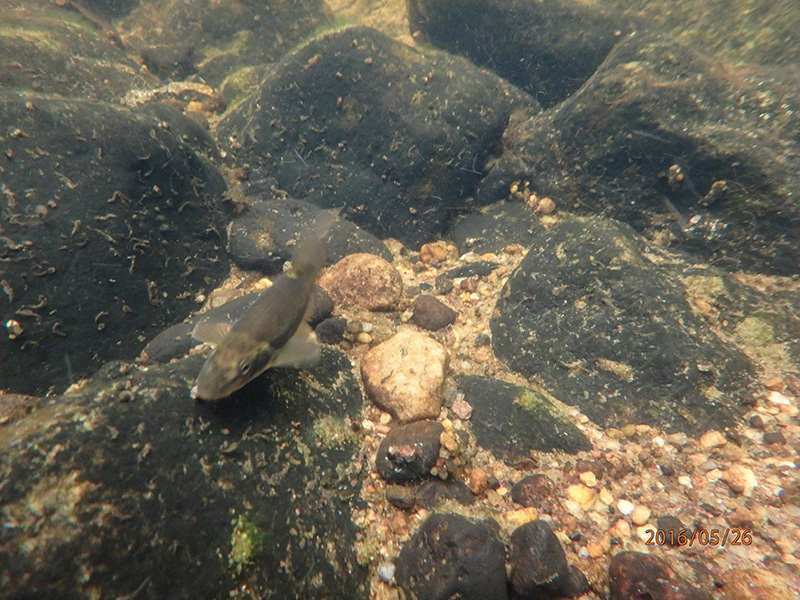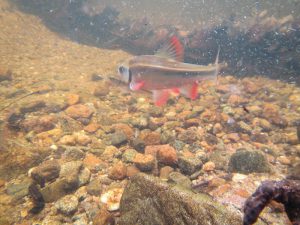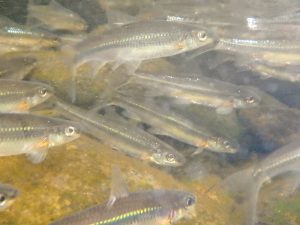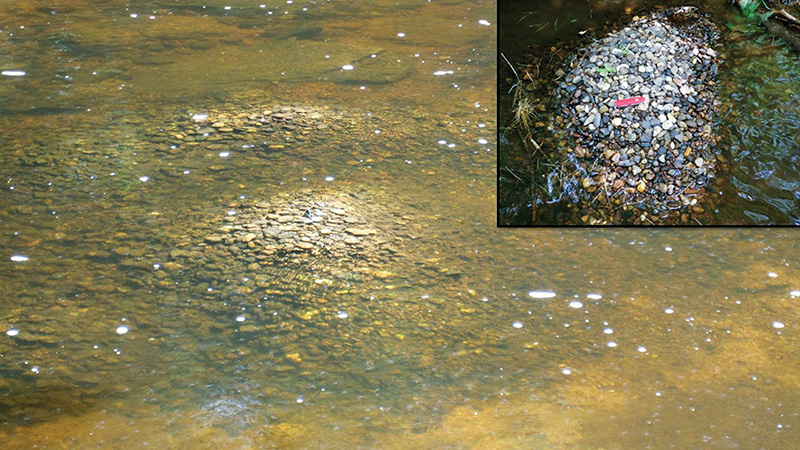
Longnose Dace with their large pectoral fins are well suited for fast flowing streams. These rocks are coated with larval stages of aquatic insects and algae that are food for these fish.

Behold the Mighty Minnow
Not Just a Small, Baby Fish
Story and Photos by Steve Gephard and Sally Harold
What do you think of when you hear the word “minnow”? Small, baby fish? In fact, there is a species of minnow in the Connecticut River that reaches fifty pounds and supports an annual fishing tournament in the Connecticut portion of the river: the Common Carp. Technically—from an ichthyologist’s point of view—a minnow is not just a small fish but a member of the family Cyprinidae, which includes over 2,000 species worldwide. There is no one characteristic that defines cyprinids, or minnows. They are a closely related group of fairly nondescript freshwater fishes that generally are small, notwithstanding our example of the carp, which was introduced from Europe over 150 years ago. The carp’s close relative, the goldfish, is also a minnow.
We’ve commented in earlier articles that it’s hard to care about things with which we aren’t familiar, and people tend to be more interested in things that are more easily seen and identified. We all recognize a monarch butterfly, but may be dismissive of the thousands of species of moths or the myriad important pollinator species besides the honeybee. In the underwater world, minnows are often dismissed. To many, they are little fish without importance or names. Other than carp, no one fishes for them; no one eats them; no one has created clubs dedicated to their conservation. Yet they are a critically important component to aquatic and terrestrial food webs and are eaten by other fish, snakes, turtles, minks, otter, and birds such as kingfishers, egrets, and herons. These fish have many names, including chubs, dace, minnows, and shiners. We’d like to introduce you to some of these.
Minnows are found throughout the Connecticut River watershed from tiny, cool headwaters to swift flowing rapids, from freshwater ponds and lakes to the tidewaters at the river’s mouth where Spottail Shiners can be found in large schools. Common Shiners, whose range includes northern Vermont and New Hampshire south to Connecticut, can be found in a variety of habitat types from rivers to brooks, and Golden Shiners can grow large enough in ponds and lakes to be caught on a hook. Longnose Dace are found in steep, cool, rushing brooks. The Finescale Dace are commonly found in boggy areas in the far north.

This male Common Shiner exhibits red flashes on its fin and whitish knobs called nuptial tubercles on its head to attract females like the one beyond it.
Learning to recognize these fish is like learning to recognize birds. You need to know where to look for them and to know their individual behaviors and traits. Although most of these minnows are not flashy—like the darters of the Tennessee River watershed—New England’s Common Shiner is a bit of a springtime showboat. The males exhibit brilliant reddish-orange fins to attract mates. Larger males can also have nuptial tubercles—rows of small horn-like bumps on their snouts—that also come and go with the breeding season. Perhaps they are fishy versions of antlers.
Minnows eat just about anything: fish, fish eggs, plants, insects, and mollusks. Depending on the individual species, they spawn between early spring and late summer. They tend to be common and well-distributed, but the diminutive Bridle Shiner, which is found in all four river states, is experiencing rapid decline. In Connecticut and Massachusetts, it is listed as “Special Concern”—one step away from being listed as “Threatened.” In New Hampshire it is listed as “Threatened,” and in Vermont it is “Critically Imperiled,” which most likely translates to “Endangered.” It is not clear why this species is in decline, but a suspected cause is loss of habitat. This minnow only grows to one or two inches in length, has a black band across its snout, and is found in slow moving waters, typically ponds.

Spottail Shiners often move in large schools in the mainstem Connecticut River.
The Spottail Shiner, whose large schools we mentioned above, is far from endangered. This slender fish can reach lengths of four inches and is found primarily in the Connecticut River main stem. It may ascend tributaries to spawn, but in Connecticut the species also forays into tributaries to feed on the eggs of spawning species like the Blueback Herring, which can carpet a streambed with hundreds of thousands of tiny eggs. In past columns, we’ve described the underwater frenzy of the Blueback Herring spawning runs, and more often than not, schools of Spottail Shiners are intermixed with the herring, grabbing eggs from the water column before they settle in amongst the rocks.
Another minnow that we see while snorkeling is the Fallfish. Typically, they are three to five inches long and not easily distinguished from other minnows of similar size. However, this species can get quite large. When they reach ten to fifteen inches in length, the males display an impressive set of nuptial tubercles, and their heads and flanks turn purple. This species is a denizen of many streams but is frequently found in fast moving trout streams that flow into the Connecticut River. Larger individuals will readily strike at a lure or fly offered by trout anglers, who feel a fight and often, mistakenly, believe they’ve got a trout on their line. Their bubble is burst upon landing a Fallfish—typically referred to as “dace” by New England anglers who do not appreciate the “bait and switch.”
Most minnows do not create nests, but the Fallfish is different. During the springtime, it builds underwater stone pyramids over which to lay its eggs. The fish picks up pebbles from the streambed in its mouth and carries them to the nest location where it deposits them in a pile. Pebble size depends on the size of the fish, but they can range from pea or blueberry size up to the size of a large marble. Multiple individuals work together to build these nests which can be reused and expanded year after year. Some nests can fill a wheelbarrow, and some can fill more than one! We’ve seen nests three feet at the base and projecting two feet above the streambed. Groups of Fallfish spawn over the pyramid of stones and the eggs settle into the crevices between the stones where they hatch and from where the tiny larvae eventually wiggle out.
The two of us have worked on many dam removal projects that not only allow migratory fish to continue upstream but also allow resident species like minnows to freely move about and reconnect with isolated populations of their own species. These projects also transform the habitat. Prior to removing a dam, the upstream habitat is ponded with slow current and aquatic vegetation, and the historically steep streambed that was once a rapid is buried under a wedge of accumulated sediment (often many feet thick). These dam impoundments (ponds) are typically dominated by non-native pond fish such as Largemouth Bass or Bluegill, and the minnow family is represented by pond species such as Golden Shiner. After a dam is removed and the sediment either excavated or flushed out, the streambed looks completely different, with exposed boulders, bedrock ledge, and fast-flowing chutes and rapids. The pond species leave and are replaced by trout, juvenile Atlantic Salmon, and fast-water specialist minnows, which quickly colonize the stream. One such specialist is the Longnose Dace, which is typically found in rapids and riffles of upland streams including the step pool streams cascading off the sides of mountains. The Longnose Dace has very large pectoral fins—like young salmon—that it uses like the wing flaps of an airplane to hold itself in place on the bottom of the fast-flowing stream. We’ve been thrilled to see how quickly Longnose Dace reappear in restored streams.
If we could get more folks in the water with a mask, fish watching could be as popular as bird watching, but it’s not an easy sell. We would enjoy your company, but in case you choose to stay dry, we’ll continue to use this column to introduce you to what’s “Beneath the Surface.” We must not assume that all that is down there are the fish that anglers pull out. The family of minnows—Cyprinidae—is often overlooked but is a mighty important part of our freshwater ecosystem.

Fallfish build large mounds of stones as nests for their eggs. In the large photo, there are two nests in the middle of the stream. A close-up is seen in the inset photo. During the spring spawning season, all of these nests would have been totally underwater.
Steve Gephard is a fisheries biologist. He recently retired after 40 years with the Connecticut Department of Energy and Environmental Protection Fisheries Division. He continues to work in the field as an independent consultant.
Sally Harold is an independent consultant for various fish passage and habitat restoration projects. Previously she worked as a fish restoration project manager for The Nature Conservancy.

